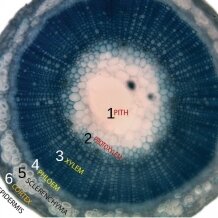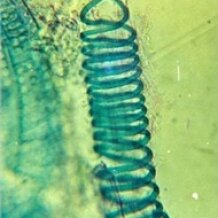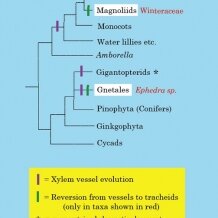Topic: Reversion from xylem vessels to tracheids
Categories: Physiology, Plants & Algae
In three plant taxa that evolved in environments with frequent freeze-thaw cycles (Winteraceae, Trochodendraceae and cold desert Ephedra), vessel evolution has been reversed independently in favour of a return to a tracheid-based vascular system.
 Vascular plants or 'tracheophytes' have specialised tissue termed xylem for conducting water and solutes. Xylem cells are elongated and connected end to end to form a tubular water-transport system throughout the plant, continuously replacing the large amount of water lost by evaporation, water that is essential for both photosynthesis (CO2 + H2O → sugars) and to maintain turgor pressure. The main kinds of xylem are tracheids and vessel elements, the latter being more specialised for efficient water conduction, reducing the costs of water loss by evapo-transpiration. Vessels have evolved independently in several plant groups, including the lycophyte Selaginella, horse-tail Equisetum, seed-ferns Marsilea and Pteridium, the Gnetales (Gnetum, Ephedra, Welwitschia), the Gnetum-like 'gigantopterids' (Gigantopteris, Gigantoclea) and most notably the angiosperms. Although vessels are better at conducting water, tracheids are advantageous in situations where there is a great deal of physical stress, such as windy or freezing conditions, when air bubbles may appear within the conduits. Selection for freezing resistant water conduits is the suggested basis for the independent reversion of three originally vessel-bearing plant lineages to tracheid-based vascular systems, providing another case of convergent evolution. The following paragraphs explain more about what tracheids and vessel elements are and how vessels have reverted to tracheids in the Winteraceae, Trochodendraceae and certain species of Ephedra.
Vascular plants or 'tracheophytes' have specialised tissue termed xylem for conducting water and solutes. Xylem cells are elongated and connected end to end to form a tubular water-transport system throughout the plant, continuously replacing the large amount of water lost by evaporation, water that is essential for both photosynthesis (CO2 + H2O → sugars) and to maintain turgor pressure. The main kinds of xylem are tracheids and vessel elements, the latter being more specialised for efficient water conduction, reducing the costs of water loss by evapo-transpiration. Vessels have evolved independently in several plant groups, including the lycophyte Selaginella, horse-tail Equisetum, seed-ferns Marsilea and Pteridium, the Gnetales (Gnetum, Ephedra, Welwitschia), the Gnetum-like 'gigantopterids' (Gigantopteris, Gigantoclea) and most notably the angiosperms. Although vessels are better at conducting water, tracheids are advantageous in situations where there is a great deal of physical stress, such as windy or freezing conditions, when air bubbles may appear within the conduits. Selection for freezing resistant water conduits is the suggested basis for the independent reversion of three originally vessel-bearing plant lineages to tracheid-based vascular systems, providing another case of convergent evolution. The following paragraphs explain more about what tracheids and vessel elements are and how vessels have reverted to tracheids in the Winteraceae, Trochodendraceae and certain species of Ephedra.
WHAT ARE XYLEM TRACHEIDS AND VESSEL ELEMENTS?
 Tracheids are elongated cells up to 80µm wide with secondary, lignified cell walls. In early-formed 'proto-xylem', secondary lignin is deposited in rings or spirals around the primary cell wall, strengthening while permitting expansion of un-lignified cellulose wall during growth. Primary cell wall is made of cellulose but is interrupted by tiny inter-cellular connections called plasmodesmata, through which small molecules may pass. In later-formed 'meta-xylem' or 'secondary xylem' (in woody plants) secondary lignin covers the whole primary cell wall, except at gaps called 'pit-pairs', where small regions of un-lignified primary wall from two adjacent cells are opposed at the middle lamella. Pit-pairs are concentrated at axial junctions (end walls) between cells, forming a pitted region called a porous pit membrane or plate. When mature, tracheid cells lose the protoplast (nucleus and cytoplasm) and die, creating an open structure for water flow, retarded only by the thin cellulose barrier of the porous pits. Functional tracheal conduits are surrounded by support and storage cells, including parenchyma, fibers and sclereids. Tracheids may have evolved as CO2 levels were decreasing from the late Silurian onwards, resulting in selection for efficient water transport (and better stomatal regulation) to counteract elevated water loss by evapo-transpiration.
Tracheids are elongated cells up to 80µm wide with secondary, lignified cell walls. In early-formed 'proto-xylem', secondary lignin is deposited in rings or spirals around the primary cell wall, strengthening while permitting expansion of un-lignified cellulose wall during growth. Primary cell wall is made of cellulose but is interrupted by tiny inter-cellular connections called plasmodesmata, through which small molecules may pass. In later-formed 'meta-xylem' or 'secondary xylem' (in woody plants) secondary lignin covers the whole primary cell wall, except at gaps called 'pit-pairs', where small regions of un-lignified primary wall from two adjacent cells are opposed at the middle lamella. Pit-pairs are concentrated at axial junctions (end walls) between cells, forming a pitted region called a porous pit membrane or plate. When mature, tracheid cells lose the protoplast (nucleus and cytoplasm) and die, creating an open structure for water flow, retarded only by the thin cellulose barrier of the porous pits. Functional tracheal conduits are surrounded by support and storage cells, including parenchyma, fibers and sclereids. Tracheids may have evolved as CO2 levels were decreasing from the late Silurian onwards, resulting in selection for efficient water transport (and better stomatal regulation) to counteract elevated water loss by evapo-transpiration.
Vessel elements are more specialised and provide even more efficient water conduction than tracheids due to having a completely open structure. They have a diameter up to 500µm and by virtue of being multi-cellular, conduits can reach lengths in excess of 10m. Vessels have evidently developed by modification of ancestral genetic programs for tracheid formation. Like tracheids, they are elongated, secondarily lignified cells that lack living contents at maturity. At the end walls of vessels, cell walls of pits completely break down when the protoplast is lost, leaving an open 'perforation plate' through which water can pass freely. The perforation plate is termed 'foraminate' if the open pores are rounded, 'scalariform' if pores are elongated and aligned like a ladder, 'reticulate' if they are arranged in a net-like pattern, and 'simple' if the whole plate is open. Initial selection for these high hydraulic conductivity structures may have been associated with a further decrease in atmospheric CO2 levels in the Cretaceous, favouring better water conduction to manage elevated transpiration in the groups (e.g. angiosperms and gnetophytes) that were diversifying at that time.
CONVERGENT LOSS OF XYLEM VESSELS IN FREEZE-THAW ENVIRONMENTS
 Xylem vessels provide greater hydraulic efficiency than tracheids, allowing easier flow of water through the plant, but tracheids retain certain advantages regarding resistance to stresses (e.g. wind and freezing) that cause gas bubble (embolism) formation. Emboli may interrupt flow and lead to implosion due to negative pressure in the empty cell cavity. Tracheids are narrower and shorter than xylem vessels, so if bubbles form they are more easily refilled with fluid via capillary action, and the porous pits restrict any temporary blockage to a single cell. In addition, relative to larger xylem vessels, tracheids require less deposition of secondary wall material to achieve a similar strength and resistance to cavitation, making them more 'economical' with respect to lignin synthesis. Gas bubble formation is a constant threat in environments where freeze-thaw cycles occur, as frozen sap leads to expanding bubbles. In three plant taxa that evolved in such conditions, vessel evolution has been reversed independently in favour of a return to a tracheid-based vascular system. These taxa include members of the Winteraceae and Trochodendraceae in the angiosperms and in the gnetophytes, certain species of Ephedra. (It has been suggested that this convergent reversal is not seen in all cold environment plants as the change was only possible in the few groups where genetic programs for vessel formation were not yet constrained through specialised integration with other parts of the cell's physiology.)
Xylem vessels provide greater hydraulic efficiency than tracheids, allowing easier flow of water through the plant, but tracheids retain certain advantages regarding resistance to stresses (e.g. wind and freezing) that cause gas bubble (embolism) formation. Emboli may interrupt flow and lead to implosion due to negative pressure in the empty cell cavity. Tracheids are narrower and shorter than xylem vessels, so if bubbles form they are more easily refilled with fluid via capillary action, and the porous pits restrict any temporary blockage to a single cell. In addition, relative to larger xylem vessels, tracheids require less deposition of secondary wall material to achieve a similar strength and resistance to cavitation, making them more 'economical' with respect to lignin synthesis. Gas bubble formation is a constant threat in environments where freeze-thaw cycles occur, as frozen sap leads to expanding bubbles. In three plant taxa that evolved in such conditions, vessel evolution has been reversed independently in favour of a return to a tracheid-based vascular system. These taxa include members of the Winteraceae and Trochodendraceae in the angiosperms and in the gnetophytes, certain species of Ephedra. (It has been suggested that this convergent reversal is not seen in all cold environment plants as the change was only possible in the few groups where genetic programs for vessel formation were not yet constrained through specialised integration with other parts of the cell's physiology.)
 The Winteraceae comprise five vessel-less genera (Drimys, Pseudowintera, Tasmannia, Takhtajania and Zygogynum) that are most closely related to Canella, within the magnoliids. Winteraceans evolved from early Cretaceous ancestors in temperate southern Gondwana but migrated to occupy regularly frozen habitats in the southern hemisphere, living in montane cloud forest, coastal rainforest and alpine shrub-land.
The Winteraceae comprise five vessel-less genera (Drimys, Pseudowintera, Tasmannia, Takhtajania and Zygogynum) that are most closely related to Canella, within the magnoliids. Winteraceans evolved from early Cretaceous ancestors in temperate southern Gondwana but migrated to occupy regularly frozen habitats in the southern hemisphere, living in montane cloud forest, coastal rainforest and alpine shrub-land.

 Outside the angiosperms, xylem vessels have been almost completely lost in cold desert species of the gnetophyte Ephedra. Here, below-zero conditions appear to have favoured reversion to tracheids in the stem. Similar environmental selection pressures presumably lead to the secondary loss of vessels in Winteraceae and Trochodendraceae, providing us with a clear example of convergence.
Outside the angiosperms, xylem vessels have been almost completely lost in cold desert species of the gnetophyte Ephedra. Here, below-zero conditions appear to have favoured reversion to tracheids in the stem. Similar environmental selection pressures presumably lead to the secondary loss of vessels in Winteraceae and Trochodendraceae, providing us with a clear example of convergence.
Cite this web page
Map of Life - "Reversion from xylem vessels to tracheids"
https://mapoflife.org/topics/topic_451_Reversion-from-xylem-vessels-to-tracheids/
September 27, 2015
(Topic created 3rd June 2009) | Last modified: 30th July 2009
Please note: words or phrases shown in bold in the PRINT VERSION of this text normally indicate hyperlinks on the webpage. These generally return a list of search results based on that keyword.